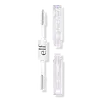What's inside
What's inside
 Key Ingredients
Key Ingredients

No key ingredients
 Benefits
Benefits

No benefits
 Concerns
Concerns

 Ingredients Side-by-side
Ingredients Side-by-side

Water
Skin ConditioningAlcohol
AntimicrobialAmmonium Acrylates Copolymer
Vp/Va Copolymer
Hydroxyethylcellulose
Emulsion StabilisingPhenoxyethanol
PreservativeButylene Glycol
HumectantPanthenol
Skin ConditioningPEG-12 Dimethicone
Skin ConditioningCaprylyl Glycol
EmollientParfum
MaskingSodium Bisulfite
AntioxidantLaurtrimonium Chloride
EmulsifyingPolysorbate 60
EmulsifyingDisodium Phosphate
BufferingSodium Phosphate
BufferingHexyl Cinnamal
PerfumingBenzyl Salicylate
PerfumingLinalool
PerfumingWater, Alcohol, Ammonium Acrylates Copolymer, Vp/Va Copolymer, Hydroxyethylcellulose, Phenoxyethanol, Butylene Glycol, Panthenol, PEG-12 Dimethicone, Caprylyl Glycol, Parfum, Sodium Bisulfite, Laurtrimonium Chloride, Polysorbate 60, Disodium Phosphate, Sodium Phosphate, Hexyl Cinnamal, Benzyl Salicylate, Linalool
 Reviews
Reviews

Ingredients Explained
These ingredients are found in both products.
Ingredients higher up in an ingredient list are typically present in a larger amount.
Hydroxyethylcellulose is used to improve the texture of products. It is created from a chemical reaction involving ethylene oxide and alkali-cellulose. Cellulose is a sugar found in plant cell walls and help give plants structure.
This ingredient helps stabilize products by preventing ingredients from separating. It can also help thicken the texture of a product.
This ingredient can also be found in pill medicines to help our bodies digest other ingredients.
Learn more about HydroxyethylcelluloseWater. It's the most common cosmetic ingredient of all. You'll usually see it at the top of ingredient lists, meaning that it makes up the largest part of the product.
So why is it so popular? Water most often acts as a solvent - this means that it helps dissolve other ingredients into the formulation.
You'll also recognize water as that liquid we all need to stay alive. If you see this, drink a glass of water. Stay hydrated!
Learn more about Water